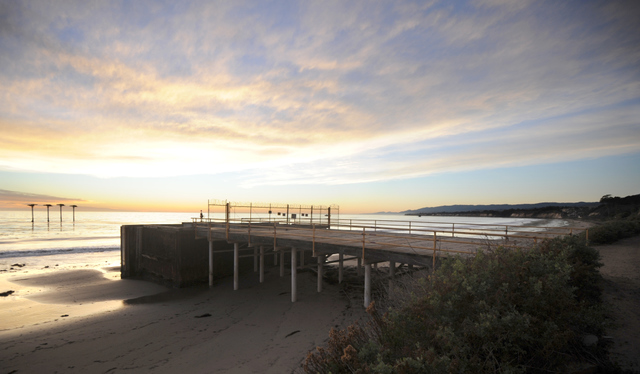Concerns Persist with Proposed Oil Extraction on Ellwood Coast
Venoco Wants to Open Well from Old Goleta Pier Near Sandpiper Golf Course

Earlier this year (as first reported here), the California State Lands Commission started examining the impacts of Venoco Inc.’s desire to re-open an old oil well located on a rusty pier off of the Ellwood Coast, adjacent to Sandpiper Golf Course and just down Haskell’s Beach from the Bacara Resort.
Both Venoco and State Lands — the agency that permits offshore and coastal drilling — believe that the Carpinteria-based company has a vested right to tap the well known as PRC 421, which was purchased from Mobil Oil in 1998, four years after a spill forced it to be shut down. More critically, both also believe that pressure is likely building in the sealed reservoir — based largely on leaks that Venoco fixed in 2000 and 2001 — and that, if untapped, the well might burst again, soiling the shoreline in potentially disastrous ways.
That all may be perfectly true, admit the City of Goleta and a collection of environmental groups represented by the Environmental Defense Center, which is why even the oil industry’s staunchest critics aren’t yet fighting this project in typical tooth-and-nail style. So as part of the environmental review process that kicked off in March, the enviros and the city asked for clarification on a number of issues, including whether there is a legally vested right, whether the “repressurization” threat is real, and whether processing the resulting oil at Venoco’s nearby Ellwood Onshore Facility (EOF) is the only alternative to consider, especially since a new pipeline now takes oil all the way up to the ExxonMobil plant in Las Flores Canyon, which is the South Coast’s officially preferred processing plant.
But more than six months of study and one 906-page environmental report later, many of those questions remain unanswered. That’s putting Goleta officials in a tight spot — “it really doesn’t give sufficient credit to the city and their decision-making role,” said city attorney Tim Giles of the draft environmental impact report, which can be read here — and shifting the enviros into a more aggressive stance. “We are disappointed,” said the EDC’s Linda Krop. “We feel that some critical analysis isn’t included. We certainly don’t have a clear understanding of what the options are.”
Specifically, the vested right issue is essentially unexamined by the report — “they don’t really even give sufficient analysis to the alternative of not even resuming it,” said Giles — and State Lands’ stance on repressurization remains the same as it was in March, which is that it will remain an unknown until the well is commercially producing again. That’s “frustrating” for Krop, who believes a separate study occur. “It’s been 13-plus years since that repressurization occurred,” she said. “Is there any evidence that it’s happening again?”
But the most thorny issue is the role of the EOF, the Venoco-owned processing plant between Sandpiper and the Bacara where the oil would be processed. In 1991, the County of Santa Barbara rezoned the land it sits upon as recreational, but allowed the EOF to persist as a non-conforming use so long as it didn’t expand or elongate operations beyond the oil that comes from Platform Holly. Around the year 2000, the county initiated an amortization study that would have closed the EOF by 2016, but that study was never finalized, getting lost in the shuffle when the City of Goleta was formed in 2002, taking jurisdiction over the facility. Nonetheless, the city, nearby residents (who are reminded of potential EOF disasters via regular alarm drills), and enviros would prefer to see the plant disappear sooner rather than later, and are wary of any project that may keep it around longer.
Though the State Lands’ report clearly states that PRC 421 would not do so — and all agree that the EOF isn’t even at its permitted capacity with Platform Holly’s oil — Giles believes that the re-opened well would represent a new source and require the city to issue a permit. (Venoco declined to answer questions for this article, but Giles says they disagree with the city’s stance on this matter.) As such, if the city were to deny such a permit, the only alternative that remains in the present report would be to process the oil on the pier itself, which clearly has more environmental risk. (The project would, it should be noted, remove the beach’s second rusty pier.)
“It’s a challenge in that their focus is solely on processing at the EOF,” said Giles. “If the State Lands Commission approves the resumption of processing without giving due consideration to where that processing is going to occur, it puts the community in a difficult position.” Instead, both he and Krop believe that State Lands should also consider an alternative project that would move the oil up to Las Flores Canyon, which is the county’s preferred processing plant.
State Lands staffers, for their part, believe that this project is much better than what Venoco initially approved in 2007, when the company wanted to process the oil on the pier and did not have plans to remove the second pier. They do not believe it will elongate the life of the EOF, they do feel the repressurization is real, and they are quick to remind that not hydraulic fracturing will occur in this project.
None of that may stop the fight that’s brewing with Goleta City Hall and others. “It’s a situation where they are able to sit back and take royalties,” said Giles. “They’re not on the frontlines of the environmental risk.”
4•1•1
The State Lands Commission is taking public comments on this project’s draft environmental impact report on Wednesday, December 11, at 3 and 6 p.m. in Goleta City Hall. Comments can also be submitted until the December 20 deadline by email to CEQAcomments@slc.gov, by phone at 916-574-1890, or by fax at 916-574-1885.



